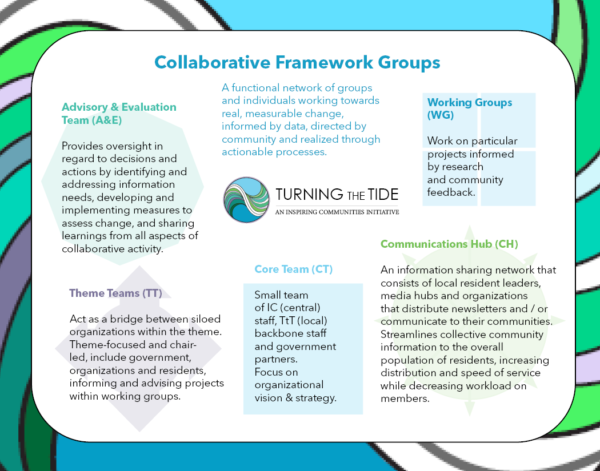How We Support Change
Framework for Change
Download the Turning the Tide Framework for Change
Community cohesiveness is measured through strengthened community engagement and connections, collaborative initiatives, and information sharing within communities and across communities. Given that the most necessary condition for the success of collective impact is trusting relationships, building these must begin within the communities and later across communities. Turning the Tide’s Framework for Change describes the long-term vision that focuses on supporting the ability of community residents to work together collaboratively.
Turning the Tide believes that if the collective impact model is to be successful then it requires providing the micro-communities with the resources to build upon and/or create cohesive communities embedded in community engagement and connections, information sharing and communities working collaboratively to achieve their respective goals. A key companion to the Framework for Change is an evaluation plan, a way to measure whether trusting relationships are being achieved. Below are the three prongs of the Framework for Change:
- Engaged and Connected: Residents feel connected to their community and are encouraged and welcomed to be actively involved in community activities and shaping the future of the area.
- Positive, Celebrating Successes: Residents take pride in their community because they are aware of its assets, accomplishments, and successes. Residents feel confident and positive about the future of their community.
- Sharing Resources: The community has established a clear and transparent pathway for residents to access resources that meets their needs. Residents are aware of where to go and how to access needed resources and information.
Evaluation Plan
Download Turning the Tide’s Evaluation Plan
Turning the Tide’s Evaluation Plan outlines information required for several purposes: learning from experience and experimentation, assessing progress toward identified outcomes, accountability to funders, meeting internal and external reporting requirements, and planning for next steps. For each of these purposes, information is required at different intervals, and is obtained from various sources and by utilizing a range of methods.
Calling on sources including interviews, reflections, feedback forms, meeting records and check-ins, our evaluation seeks to assess the following:
- Increased number of community and cross-community events, activities, and projects; enhanced engagement with these, including more / different people;
- Community members able to discuss, reflect on, and learn from these, what worked well, what could have been done differently, and to plan for future collaborative efforts
- Community members meeting and learning more about and from other people from across the Digby area
- Indications of increasing trust among community members
- Improved means of information sharing about community events and activities,
- Positive stories about events, successes, and accomplishments in the area are in circulation;
- Community serving organizations, groups, and government partners meet to exchange information on services, resources available in the area, and on eligibility and access requirements;
- Identification of barriers to accessing current services/ resources, and gaps in needed services and resources, and planning for a navigation system to resources for the area.
Collaborative Framework
We structure our work within a Collaborative Framework, a functional network of groups and individuals working towards real, measurable change, informed by data, directed by community and realized through actionable processes. The Collaborative Framework Groups are:
Theme Teams (TT)
- Act as a bridge between siloed organizations within the theme.
- Theme-focused and chair-led, include government, organizations and residents, informing and advising projects within working groups.
Working Groups (WG)
- Work on particular projects informed by research and community feedback.
Advisory & Evaluation Team (A&E)
- Provides oversight in regard to decisions and actions by identifying and addressing information needs, developing and implementing measures to assess change, and sharing learnings from all aspects of collaborative activity.
Core Team (CT)
- Small team consisting of Inspiring Communities’ (central) staff, Turning the Tide (local) backbone staff and government partners.
- Focus on organizational vision and strategy.
Communications Hub (CH)
- An information sharing network that consists of local resident leaders, media hubs and organizations that distribute newsletters and / or communicate to their communities.
- Streamlines collective community information to the overall population of residents, increasing distribution and speed of service while decreasing workload on members.
